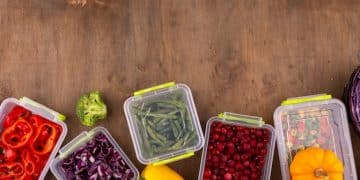5 Proven Tips to Reduce Sugar in Family Recipes by 25%

Looking to reduce sugar in your family’s favorite recipes? These 5 actionable tips will help you cut down sugar by 25% without sacrificing taste, making your meals healthier and more enjoyable for everyone.
Want to enjoy your family’s cherished recipes with a little less guilt? It’s easier than you think to reduce sugar without anyone noticing. Let’s explore 5 tips for reducing sugar in family recipes by 25%.
Understand the Role of Sugar in Your Recipes
Before you start slashing sugar, it’s important to understand why it’s there in the first place. Sugar isn’t just about sweetness; it plays several crucial roles in baking and cooking.
Understanding the functions of sugar allows you to make informed decisions about how to reduce it while maintaining the desired results.
Functions of Sugar in Baking
Sugar does more than just sweeten. Knowing what it contributes can guide your adjustments.
- Moisture: Sugar is hygroscopic, meaning it attracts and retains moisture, keeping baked goods soft and preventing them from drying out too quickly.
- Structure: Sugar interferes with gluten development, which is vital for creating tender baked goods with a light crumb.
- Browning: Sugar caramelizes during baking, contributing to the golden-brown color and rich flavor of many recipes.
- Leavening: Sugar provides food for yeast in recipes like bread and cakes, aiding in the leavening process and creating a light, airy texture.
Considering these factors will help you to modify the sugar content without compromising the quality of the recipe.
In short, recognizing the multifaceted contribution of sugar helps cooks make intelligent, recipe-sensitive decisions for optimization.
Start with Small Reductions
The easiest way to reduce sugar is to simply use less of it. This method is often surprisingly effective, especially if you start with small changes.
Gradual reductions are far less noticeable and can help your family adjust to the lower sugar levels over time.
Gradual Approach
Instead of making a drastic cut all at once, reduce the sugar content incrementally.
Begin by reducing the sugar in your recipe by just 10%. For example, if the recipe calls for 1 cup of sugar, use 7/8 cup instead.
Test and Adjust
After baking or cooking, taste the dish and see if you notice a significant difference. If not, reduce the sugar by another 10% next time you make the recipe.

Continue this process until you reach a point where you feel the sweetness is just right, or until you’ve reached your goal of a 25% reduction.
The method is effective enough that you can usually achieve noticeable health benefits without compromising taste.
Swap Refined Sugar for Natural Sweeteners
Another strategy is to replace some or all of the refined sugar with natural sweeteners. These alternatives often have additional health benefits and can add unique flavors to your dishes.
Consider experimenting with different natural sweeteners to find the ones that work best for your family’s taste preferences.
Examples of Natural Sweeteners
There’s a wide range of naturally sourced sugars to use in healthier cooking practices.
- Honey: Offers antioxidants and a distinct flavor. Use slightly less honey than sugar, as it’s sweeter and contains more moisture.
- Maple Syrup: Adds a rich, caramel-like flavor. Choose pure maple syrup for the best taste.
- Applesauce: Unsweetened applesauce can replace some of the sugar and add moisture to baked goods.
- Dates: Pureed dates can provide sweetness, fiber, and nutrients. They work well in smoothies and baked goods.
Make sure to adjust liquid ingredients accordingly when using alternatives to prevent a change in overall food texture.
Experimentation is key to finding the best way to incorporate natural sweeteners—or just learning how well the substitutes function.
Incorporate Fruit and Spices for Flavor
Often, a lack of sweetness isn’t about missing sugar alone, but about missing flavor complexity. You can enhance the flavor of your recipes naturally by adding fruits and spices.
These additions can boost the perceived sweetness and overall appeal of your dishes.
Fruit Purees and Concentrates
Fruits naturally provide sweetness and can supplement or altogether replace sugar.
Add fruit purees like mashed bananas, pumpkin, or berries to your recipes. These purees not only add sweetness but also provide moisture and nutrients.
You can use concentrated fruit juices to enhance sweetness as well. Apple or grape juice concentrates are excellent options.
Spice it Up
Spices are excellent for creating flavors that distract the palate and make meals feel more robust.
- Cinnamon: Enhances the perception of sweetness and adds warmth.
- Nutmeg: Provides a subtle, nutty flavor that complements many desserts.
- Vanilla Extract: Amplifies the sweetness and adds depth.
- Allspice: Offers a warm, complex flavor similar to cinnamon, cloves, and nutmeg combined.

These ingredients can help to create a richer, more satisfying taste experience and decrease the desire for sugary components.
Combining fruit and spices diversifies your flavor wheel to reduce the need for sugar volume.
Be Mindful of Hidden Sugars
Sugar can sneak into your diet through unexpected sources. Pay attention to ingredient labels and be aware of hidden sugars in processed foods.
Make informed choices to avoid unnecessary sugar intake and to further reduce the overall sugar content in your family’s meals.
Read Labels Carefully
Be vigilant about reading the labels on packaged foods. Sugar can be listed under many different names.
Look out for ingredients like high fructose corn syrup, sucrose, glucose, dextrose, and maltose. These are all forms of sugar.
Make Homemade Versions
Prepare homemade versions of snacks, dressings, and sauces. This will allow you total control over the ingredients and eliminate hidden sugars.
- Salad Dressings: Many store-bought dressings are loaded with sugar. Make your own with olive oil, vinegar, and herbs for a healthier option.
- Tomato Sauce: Some tomato sauces contain added sugar to balance the acidity. Opt for no-sugar-added varieties or make your own from scratch.
- Snacks: Instead of buying sugary snacks, prepare homemade granola bars, trail mix, or fruit salads.
Homemade alternatives can significantly decrease the likelihood of unknowingly consuming excess sugars.
The ability to monitor and adjust individual ingredients guarantees a reduction in hidden sugars.
| Key Point | Brief Description |
|---|---|
| 💡 Small Reductions | Decrease sugar incrementally (e.g., by 10%) to adjust without altering taste drastically. |
| 🍯 Natural Swaps | Replace refined sugar partially with alternatives like honey, applesauce, or fruit purees. |
| 🍎 Flavor Boost | Enhance flavor using fruits & spices – cinnamon, vanilla, berries – to compensate for sugar reduction. |
| 🧐 Mindful Labels | Check ingredient labels for hidden sugars and opt for homemade versions where possible. |
Frequently Asked Questions
▼
Reducing sugar intake can lead to better weight management, decreased risk of type 2 diabetes, improved dental health, and enhanced cardiovascular health.
▼
Sugar not only sweetens but also impacts texture, moisture, and browning. It retains moisture, creates tenderness, caramelizes during baking, and aids in leavening.
▼
Use spices like cinnamon or vanilla extract. Incorporate fruit purees like mashed bananas, or use unsweetened applesauce to enhance natural flavor.
▼
Watch out for high fructose corn syrup, dextrose, sucrose, or maltose. All are sugar. Choose options with little or no added sugars to remain healthy.
▼
Yes. Even small reductions in sugar intake support significant health improvements, including stabilized energy levels, better mood, and healthier skin.
Conclusion
Reducing sugar does not mean sacrificing flavor. With these 5 tips for reducing sugar in family recipes by 25%, you can create healthier versions of your favorite dishes that everyone will enjoy. Gradual adjustments, strategic substitutions, and mindful ingredient choices can make a big difference in your family’s overall health and well-being.





